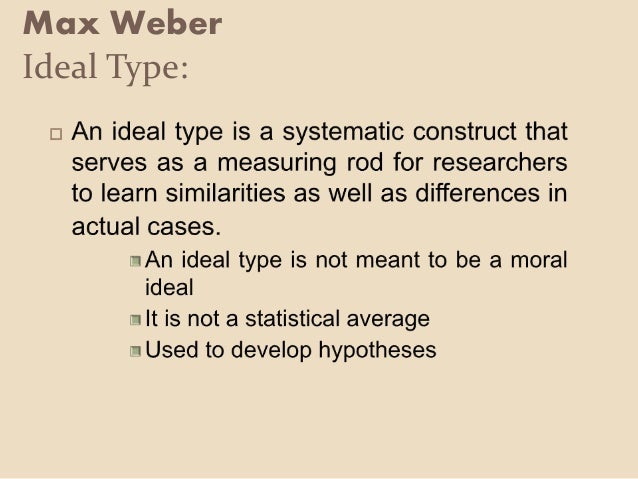Relevance: Sociology: Paper I: Sociological Thinkers: Max Weber: Ideal types
Weber’s “Ideal Types”
The ‘ideal type’ is one of Weber’s best known contributions to contemporary sociology. It occupies a very important place in his methodology. Weber believed, it was the responsibility of sociologists to develop conceptual tools. The most important of such conceptual tool is the ideal type.
Definition and Meaning:

According to New Websters Dictionary ‘Ideal’ is a “conception or a standard of something in its highest perfection.” It refers to mental image or conception rather than a material object. It is a model. The term type means a kind, class or group as distinguished by a particular character. So generally, we may conceptualize ideal type as a kind, category, class or group of objects things or persons with particular character that seems to be the best example of it.
Weber used Ideal type in a specific sense. To him Ideal type is a mental construct, like a model, for the scrutiny and systematic characterization of a concrete situation. Indeed he used Ideal type as a methodological tool to understand and analyze social reality.
Methodology is a conceptual and logical research procedure by which knowledge is developed. Historically much of the methodological concern in the social sciences has been directed towards establishing their scientific credentials.
Max Weber was particularly concerned with the problem of objectivity in social sciences. Hence he used Ideal type as a methodological tool that looks at reality objectively. It scrutinizes, classifies, systematizes and defines social reality without subjective bias. The Ideal types are nothing to do with values. Its function as a research tool is for classification and comparison.
To quote Max Weber:
“The Ideal typical concept will develop our skill in imputation in research. It is not a description of reality but it aims to give unambiguous means of expression to such a description.” In other words, Ideal types are concepts formulated on the basis of facts collected carefully and analytically for empirical research. In this sense, Ideal types are constructs or concepts which are used as methodological devices or tools in our understanding and analysis of any social problem.
Just as an ideal model is constructed by the natural scientists as an instrument and means for knowing nature, so the social scientist creates Ideal type as a tool for systematizing and comprehending individual facts, against which the investigator can measure reality. It is because of its separation from empirical reality and difference from it.
Weber tells, the Ideal type could serve as a measuring rod of reality. The object of constructing “Ideals types” is not to compare an empirical situation with the ideal type, but to compare several empirical situations with one another; through the medium of Ideal type and derive testable hypothesis which account for the various deviations. In other words Ideal types help to guide and structure comparative research.
According to Weber, the Science of sociology could be developed on the basis of the concept, the Ideal type. Weber says, sociology is concerned with social action and social behaviour. Every social action has an ideal. The ‘Ideal type’ of social action is in our mind. For example, we say that a particular man is ‘idealist’.
The term idealist is an idea and how can we call a man idealist? How can we apply an idea to a concrete man? It is only because we have conception about the meaning of the term idealist and this conception is an idea of the Ideal type. It is because of these theoretical and rational concepts that we are able to judge a man as idealist. This proves that everyman has in him certain ideas about perfect social action or behaviour and this ideal type is subjective that is in the mind of man.
Julien Freund writes, “by the ideal type the sociologist is able to measure the gap between the ideal typical objectively possible action and the empirical action an ascertain the part played by irrationality and chance or by the intrusion of accidental, emotional and other elements.”

According to Weber:
“An ideal type is formed by the one-side accentuation of one or more points of view and by the synthesis of a great many diffuse, discrete, more or less present and occasionally absent, concrete individual phenomena, which are arranged according to those one-sidedly emphasized viewpoints into a unified analytical construct. In its conceptual purity, this mental construct…. cannot be found empirically anywhere in reality.”
In-spite of the above definition, Weber was not totally consistent in the way he used the Ideal type. At its most basic level, an Ideal type is a concept constructed by a social scientist on the basis of his interests and theoretical orientation, to capture the essential features of some social phenomenon. The Ideal type, one of the most important concepts of Weber represents the logical conclusion of several tendencies of Weberian thought.
(1) It is related to the notion of comprehension. In that every Ideal type is an organization of intelligible relations within a historical entity or sequence of events.
(2) Moreover, the Ideal type is related to a characteristic of both our society and our science, namely the process of rationalization. The construction of Ideal type, Raymond Aron writes, “is an expression of the attempt; characteristic of all scientific disciplines to render subject matter intelligible by revealing or constructing its internal rationality.
(3) Ideal type is also related to the analytic and partial conception of causality. It helps us to understand historical elements or entities, but it is so to speak a partial comprehension of a total whole.
Construction of Ideal types:
Ideal types are formulated by the abstraction and combination of an indefinite number of elements which though found in reality, are rarely or never discovered in specific form. Therefore Weber does not consider that he is establishing a new conceptual method. He emphasizes that he is making explicit what is already done in practice. For the construction of Ideal types, the sociologist selects a certain number of traits from the whole which is otherwise and obscures, to constitute an intelligible entity.
For example:
If we wish to study the state of .democracy in India, then our first task will be to define the concept of democracy with the help of its essential and typical characteristics. Here we can mention some of the essential characteristics of democracy. That is existence of multi-party system, universal Adult Franchise, formation of Govt. by people’s representatives, people’s participation in the decision making, and equality before law as well.
This formulation of a pure type or an Ideal type concept of democracy will guide us and work as a tool in our analysis. Any deviation from or conformity to it will unfold the reality. Ideal types therefore do not represent the common or the average characteristics but focus on the typical and the essential characteristics.
For instance in his book the Protestant Ethics and the Spirit of Capitalism, Weber analyses the characteristics of the “Calvinist Ethic.” Ideal types are constructed from facts existing in reality. They do not represent or describe the total reality; they are of pure types in a logical sense. According to Weber in its conceptual purity, this ideal mental construct cannot be found empirically anywhere in reality. This then is the way in which Ideal types are constructed.
According to Max Weber, “An ideal type is an analytical construct that serves the investigator as a measuring rod to ascertain similarities as well as deviations in concrete cases.” Weber urged that the basic purpose of the Ideal type is “to analyze historically unique configurations or the individual components in terms of genetic concepts.” They are used as conception instruments for comparison with and the measurement of reality. They are indispensable for this purpose.
Ideal types are to be constructed and used with care, says Weber. Max Weber cautions that the Ideal type is to be constructed and used with great care.
He stated:
- The Ideal types are not hypotheses.
- Ideal types do not state or imply an ethical ideal.
- They do not state an average type.
- They do not exhaust reality, i.e., they do not correspond exactly to any empirical instances.
Purpose and use of Ideal types:
Ideal types are not formed out of a nexus of purely conceptual thought, but are created, modified and sharpened through the empirical analysis of concrete problems. This in turn, increases the precision of that analysis. Ideal type, a key term in Weber’s mythological essays has been used by him as a device in understanding historical configurations or specific historical problems.
For this he constructed Ideal types that are to understand how events had actually taken place and to show that if some antecedents or other events had not occurred or had occurred differently, the event we are trying to explain would have been different as well. For example, because of the implementation of the land reform laws and penetration of other modernizing forces like education, modern occupation etc. the joint family system has broken down in rural India. This means that there is a causal relation between the event (Land reform, education etc.) and the situation (Joint family). In this way Ideal type concept also helps in the causal explanation of a phenomenon.
Weber does not believe that one element of society is determined by another. He conceives the causal relations both in history and sociology as partial and probable relations. It means that a given fragment of reality makes probable or improable, favourable or un-favourable to another fragment of reality.
For instance:
Certain Marxists would say that private ownership of the means of production makes inevitable the political power of the minority possessing these means. Weber would say that an economic regime of total planning makes a certain type of political organisation more probable.
In Weber’s work such analysis of causal relationships was related to his interest in worldwide comparisons or in analysis of events and establishment of general proposition. That is he used Ideal types to build up a conception of a particular historical case, and used the same Ideal type conceptions for a comparative analysis. This interdependence of history and sociology appears most clearly in Weber’s conception of the Ideal type. Besides examining any particular historical case Weber also used Ideal types to analyze the abstract elements of social reality and to explain particular kinds of social behaviour.
For more such notes, Articles, News & Views Join our Telegram Channel.
Click the link below to see the details about the UPSC –Civils courses offered by Triumph IAS. https://triumphias.com/pages-all-courses.php

